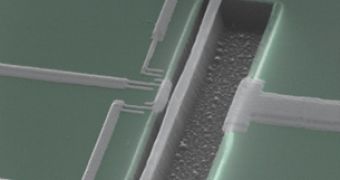Imagine staring at a drum in such a focused way that it starts to beat. This is what happens if the drum is only 8.7 microns, or millionths of a meter, long, 200 nanometers, or billionths of a meter, wide and you look at it with an incredibly precise electronic microscope. Such a drum has about ten thousand billion atoms, but quantum mechanical effects can nonetheless be observed.
According to Heisenberg's uncertainty principle, measuring the position of something changes its velocity and vice-versa. This creates a limit on the precision with which you can measure simultaneously both the position and the velocity.
Keith Schwab, Cornell associate professor of physics, has now created a device that approaches this limit (called Plank constant) by measuring simultaneously the position and velocity of a tiny drum made from a piece of silver on top of silicon nitride and pinned down at both ends so it could vibrate in the middle. Schwab's team used a superconducting single electron transistor (SSET) to detect the miniscule changes in silver's position. The image shows a scanning electron microscope image of the aluminum and silicon nitride resonator coupled to the SSET.
"We made measurements of position that are so intense -- so strongly coupled -- that by looking at it we can make it move," said Schwab. "Quantum mechanics requires that you cannot make a measurement of something and not perturb it. We're doing measurements that are very close to the uncertainty principle; and we can couple so strongly that by measuring the position we can see the thing move."
The scientists also made an unexpected discovery: they found that as they watched the device, it cooled. This process is analogous of the laser cooling, which is a well known procedure of cooling a gas by shining laser light on it. As the photons bounce off the gas molecules, they take some of their kinetic energy and thus leave the gas cooler. This is the first time the same kind of phenomenon was observed with electrons instead of photons and with a solid instead of a gas.
"By looking at it you can not only make it move; you can pull energy out of it," said Schwab. "And the numbers suggest, if we were to keep going on with this work, we would be able to cool this thing very cold. Much colder than we could if we just had this big refrigerator."
Although this cooling phenomenon is very interesting, Schwab says he is more curious about finding out whether quantum mechanics applies to macroscopic objects (such as this fairly large device) or not. After determining that Heisenberg's principle does indeed apply, he now plans to do another experiment testing another fundamental principle of quantum mechanics: the superposition principle.
This principle is used to compute the probabilities of some event (such as going from A to B) by considering that all the possible trajectories happen in parallel and influence each other (their "amplitudes of probability" are summed up). Given that we are not used to seeing the same thing in more than one position at a time one can wonder where exactly does the superposition principle break down.
"We're trying to make a mechanical device be in two places at one time. What's really neat is it looks like we should be able to do it," he said. "The hope, the dream, the fantasy is that we get that superposition and start making bigger devices and find the breakdown."

 14 DAY TRIAL //
14 DAY TRIAL //